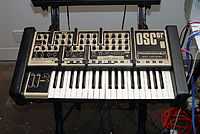OSC OSCar
 OSCar | |
| Manufactured by | Oxford Synthesiser Company |
|---|---|
| Dates | 1983 - 1985 |
| Technical specifications | |
| Polyphony | 1 voice |
| Timbrality | 1 |
| Oscillator | 2 digital oscillators per voice |
| LFO | 1 triangle/sawtooth/square/sample & hold |
| Synthesis type | Analog/Digital Hybrid Subtractive Additive |
| Filter | 1 resonant multi-mode (lowpass/bandpass/hipass) filter |
| Attenuator | 2 ADSR |
| Memory | 24 patches |
| Input/output | |
| Keyboard | 37 keys |
| External control | MIDI |
The OSCar was a synthesizer manufactured by the Oxford Synthesiser Company from 1983 to 1985. It was ahead of its time in several ways and was one of the few mono-synths to have MIDI.[1] Around 2000 were made.[2]
History
When synthesizer manufacturer Electronic Dream Plant folded in 1982, Chris Huggett went on to form the Oxford Synthesiser Company.[2] The OSCar synthesizer was launched in 1983. Chris Huggett designed the electronics while independent product designer Anthony Harrison-Griffin was responsible for the unique look and build of the OSCar.[3]
Design and features
Harrison-Griffin's use of distinctive black rubberized components to protect the controls and main casing became one of the instrument's most distinctive visual features. He even built into the ends a dummy 3-pin main socket to safely store the plug.[citation needed]
Although the basic structure of the OSCar is the common subtractive synthesis model, it has many unusual features and design quirks. The main difference from other synthesizers of the time was its digital oscillators and control system. The oscillators have an array of standard wave shapes including triangle, sawtooth, square and a variable pulse-width modulation, but the digital system also provides additive synthesis. New waveforms can be created by changing the amplitudes of up to 24 harmonics, widening the available sound palette in comparison with purely analogue synths. The two oscillators can either be played together monophonically, or the OSCar can be set in a duophonic mode where each oscillator plays a different note.[2]
The filter was actually two 12dB/Oct analog filters that can be combined into either a 24dB low pass, a 24dB high pass or a 12dB bandpass filter. Although this design appeared in other analog synths of the era, such as the Roland Jupiter-6, the OSCar has its own unique twist on it, by having a "Separation" control that allowed you to separate the filters' cutoff frequencies. This created two resonance peaks in the filter, giving a unique "vocal" character.[2]
The OSCar has an elementary sequencer. In duophonic mode it allows the user to play a monophonic lead whilst a sequence plays simultaneously. Many sequencers at the time only allowed notes of a fixed length to be used in their sequencers but on the OSCar it was possible to lengthen individual notes or insert spaces.[4]
Users
Although only 2000 OSCars were made they found their way into many professional hands. Ultravox used one for the solo on Love's Great Adventure, and it is used for the bass on Stevie Wonder's Skeletons, Jean-Michel Jarre's Revolutions Overture, Seaweed (British musician) of Ozric Tentacles used one in his rig and perhaps most notably on Do They Know It's Christmas.[2]
Emulation
The GForce impOSCar is a software emulation of the OSC OSCar.[citation needed]
See also
References
- ↑ Russ, Martin (2004). Sound synthesis and sampling. Oxford: Focal press. p. 153. ISBN 0-240-51692-3. Retrieved 2010-08-23.
- ↑ 2.0 2.1 2.2 2.3 2.4 Wiffen, Paul (September 1999). "LIFE OF OSCAR". Sound on Sound. ISSN 0951-6816. Retrieved 2010-08-22.
- ↑ "Anthony Harris-Griffin (blog)". Retrieved 2010-08-22.
- ↑ "Oxford Synthesiser Company • OSCar". Retrieved 2010-08-23.
Further reading
- Mark Vail, Vintage Synthesizers: Groundbreaking Instruments and Pioneering Designers of Electronic Music Synthesizers, pub Backbeat Books (2000), ISBN 0879306033
External links
- The OSCar pages - website dedicated to the OSCar
- Vintage Synth Explorer - listing for OScar